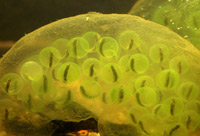Algae within the cells of spotted salamander embryos.
Click image to enlarge Salamander embryos grow inside egg capsules that are covered with and usually infiltrated by a specific type of green algae. Photo courtesy Roger Hangarter / Indiana University. |
A species of algae long known to associate with the spotted salamander (Ambystoma maculatum) has now been discovered to actually live within the cells of its developing embryos, according to a team of scientists from the U.S. and Canada. This is the first known example of a eukaryotic algae living stably inside the cells of any vertebrate.
“It raises the possibility that more animal/algae symbiosis exist that we are not aware of,” said Indiana University Bloomington biologist Roger Hangarter, the report’s sole American coauthor. “Since other salamanders and some frog species display similar algae/egg symbiosis, it is possible that some of those will also have the type of endosymbiosis we have seen in the spotted salamander.”
“We were particularly excited to discover this association in spotted salamander embryos, because this species was a model organism for early experimental embryology research and is a locally common salamander in eastern North America,” study author Ryan Kerney explained. “We hope that this study will highlight biodiversity research on common North American species, which can easily be overlooked or even considered over-studied.”
The rarity of vertebrate endosymbiosis, as the cell-within-a-cell association is called, is thought to be the result of the highly-effective immune systems of these animals. Any foreign cell that manages to get as far as breaching a vertebrate cell membrane is then treated as hostile and normally destroyed.
Original Observations
Naturalists first noticed an association between spotted salamander eggs and green algae more than 100 years ago. This relationship was formalized by name in 1927 by Lambert Printz, who named the algal species Oophilia amblystoma, with its generic name meaning “egg-loving.”
The nature of this mutually-beneficial relationship or symbiosis was not discovered until the 1980s, when experimentation revealed the salamander embryos do not develop as quickly or as fully in the absence of the green algae. Likewise, algae grown separately from the embryos but in the presence of water exposed to the embryos also grew more robustly.
Despite decades of study however, the revelation of an endosymbiosis between the amphibian and algae took many by surprise when Kerney presented his preliminary information at a scientific meeting. The reason, according to Hangarter, is that the algae cells were not easy to see by conventional light microscopy. Because the chlorophyll in the algae is highly fluorescent however, the scientists were able to use modern fluorescent microscopy to display its whereabouts.
They also used a short string of nucleic acids that targets and binds to a ribosomal RNA molecule unique to Oophilia, and by utilizing a visualization technique called fluorescence in situ hybridization, they were able to confirm that the algae RNA is actually present within the spotted salamander embryo cells.
“With the ability to use gene-specific probes, it is now possible to determine the presence of organisms that may not be easily visible by standard light microscopy,” Hangarter said. “In the past, researchers looking with simpler light microscopy techniques than are available today simply failed to see any algae in the salamanders.”
* The paper Intracellular invasion of green algae in a salamander host by Ryan Kerney, Eunsoo Kim, Roger P. Hangarter, Aaron A. Heissa, Cory D. Bishop and Brian K. Hall, published in the Proceedings of the National Academy of Sciences, is online here.

